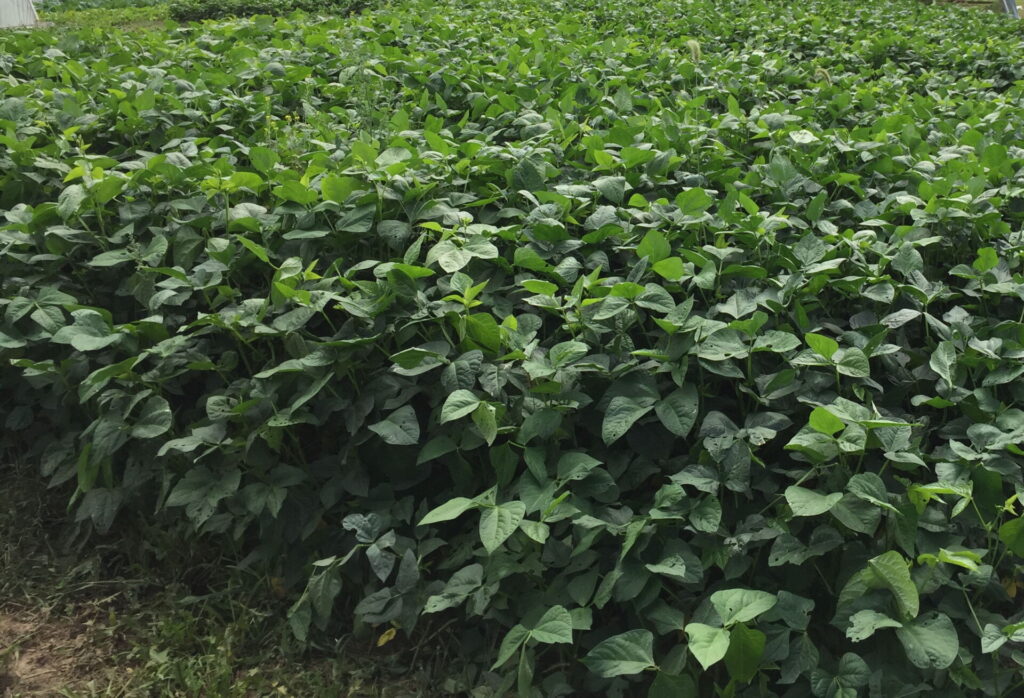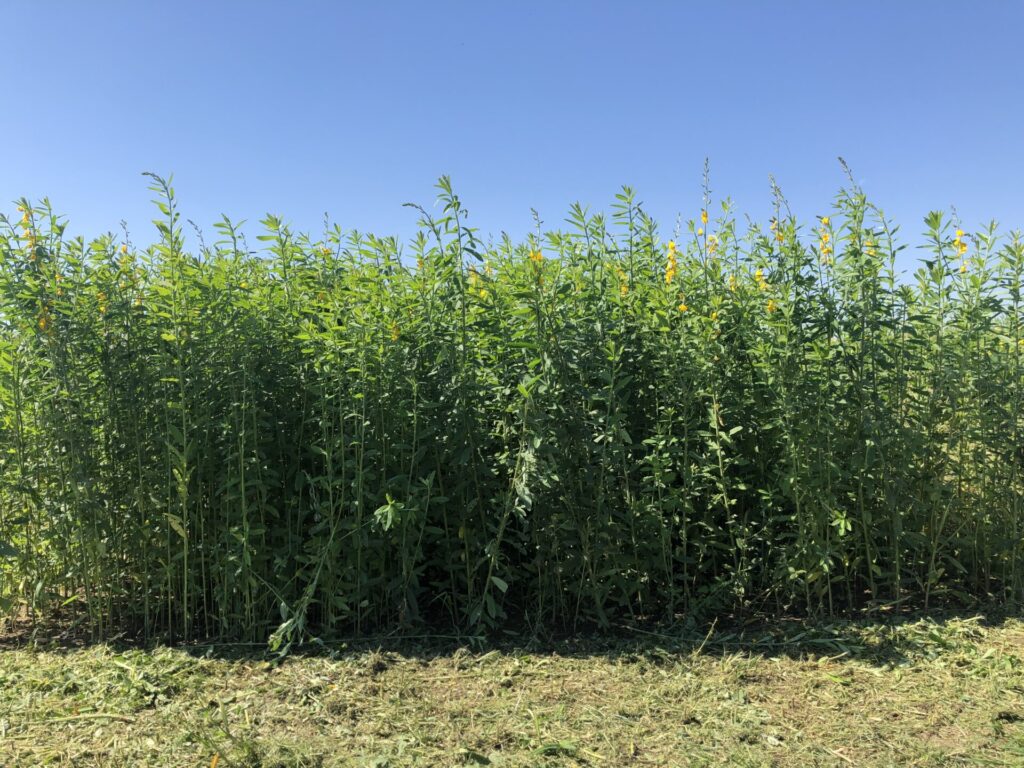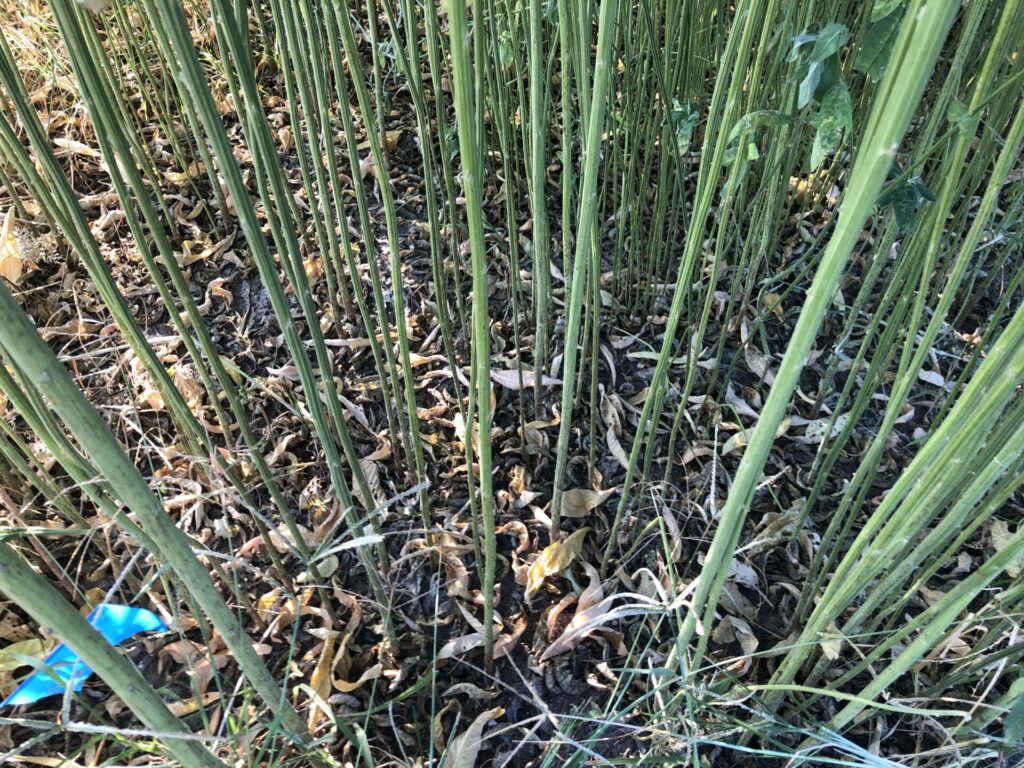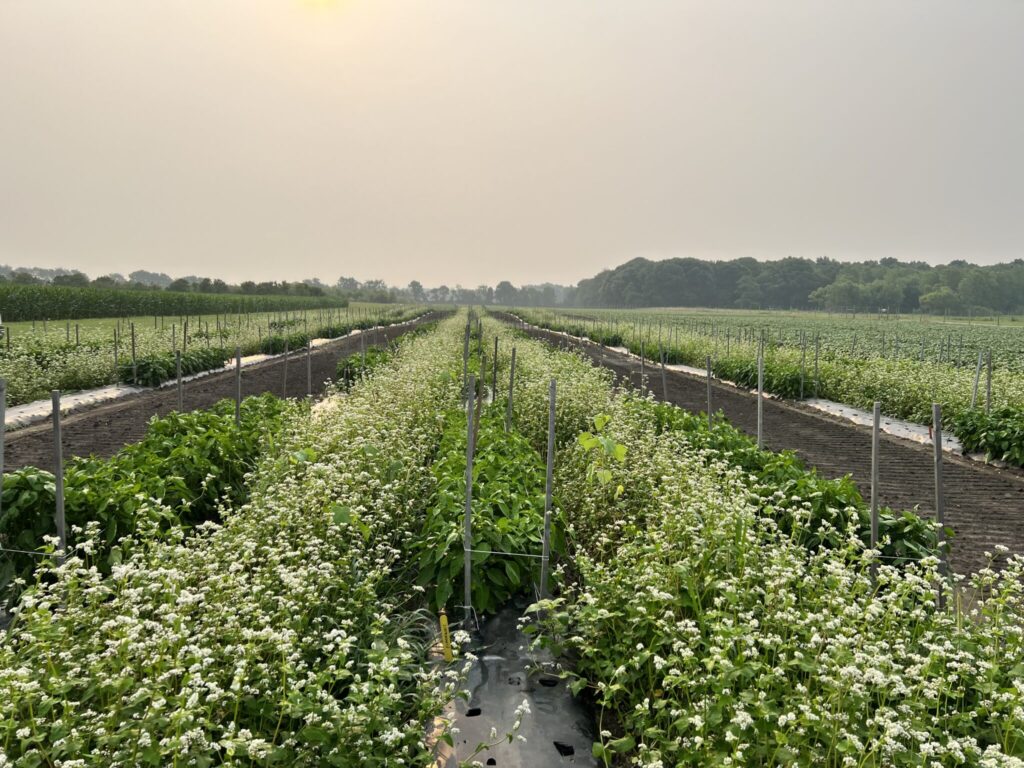Summer cover crops offer clear benefits to vegetable growers and the environment. Cover cropping offers clear benefits to growers and the environment. It is a valuable opportunity to add organic material to the soil, and it increases soil carbon, enhances soil fertility and nitrogen cycling, reduces erosion, and helps to reduce weed pressure in subsequent cash crops. Building soil health requires a lot of biomass, and summer cover cropping can provide a sustainable solution. When planted after early spring vegetable harvests or during fallow periods, summer cover crops can transform bare soil into productive, biologically active ground that benefits successive crops. This article focuses on four proven summer cover crop options: sorghum sudangrass, sunn hemp, buckwheat, and cowpea.
Benefits of Summer Cover Crops
Summer cover crops provide multiple benefits for vegetable production systems. They protect soil from erosion during heavy summer rains, add organic matter to improve soil structure, and can supply significant amounts of nitrogen for the following crops when legumes are used. Non-leguminous cover crops can utilize nitrogen in the plant-soil system by assimilating it into the biomass. Cover crops suppress weeds while their abundant blossoms attract pollinators and beneficial insects, creating conditions for a more balanced farm ecosystem. Additionally, these living mulches help regulate soil temperature and conserve moisture during hot summer periods.
Sorghum Sudangrass (Sorghum × drummondii)
Sorghum sudangrass, sometimes called sudex, is a heat-loving hybrid cover crop species that excels at building biomass in hot conditions. No other cover crop is like sorghum-sudangrass for adding organic matter to soils, and it can produce impressive amounts of dry matter.
Establishment and Management
In Indiana, a reliable establishment window is from May 20 to August. Earlier plantings will produce more biomass. Plant when soil temperatures reach 65°F or higher for best germination. Seeding rates range from 20 to 50 pounds per acre, with 30 pounds per acre for modest biomass production or 50 pounds per acre for effective weed suppression. Plan for 60-70 days to be an effective growth period.
Sorghum sudangrass grows up to 12 feet tall. Stalks can reach up to 0.5 inch in diameter, and the plants can generate very aggressive and large root systems. Under good conditions, the crop typically produces about 4,000 to 5,000 pounds of dry matter per acre.
Benefits and Considerations
Sorghum sudangrass is particularly valuable for building soil organic matter and reducing root-knot nematode pressure. The crop’s deep root system reduces subsurface hardness, making it excellent for improving soil structure. The extensive root system helps alleviate soil compaction and stabilize the soil while adding significant organic matter. It can be cut up to four times during the growing season, cutting it every 4-6 weeks.
Termination challenges are the most significant disadvantage to using sorghum sudangrass in a vegetable production system. The crop requires heavy-duty equipment like a flail mower and an offset disc harrow for effective termination, and needs about 40 pounds of nitrogen per acre at planting to grow well. Sorghum sudangrass produces a lot of biomass with a high C:N ratio, which may immobilize nitrogen and reduce nitrogen availability in the next crop. Intensive vegetable production systems can manage the nitrogen negative period by using integrated fertility management techniques.
Sunn Hemp (Crotalaria juncea)
Sunn hemp is a tropical legume that adapts well to temperate growing conditions, making it an excellent summer cover crop option. Its rapid growth rate combined with strong nitrogen-fixing ability makes it particularly valuable for producers seeking to add nitrogen, increase surface residue, suppress weeds during fallow periods, and enhance overall soil health.
Establishment and Performance
Sunn hemp is a tropical plant, and the optimum soil temperature for planting is more than 50°F. In Indiana, the best time to establish Sunn hemp is between the first week of June and the end of July. Plant 15-25 pounds per acre at 0.5-1 inch depth.
Sunn hemp grows rapidly and can produce 2.5 tons of biomass and 120 pounds of nitrogen per acre over a 60-to-90-day period. Research shows it can be particularly effective when mixed with other summer covers. Sunn hemp and sorghum sudangrass are often mixed, creating complementary benefits.
Management Considerations
Mow Sunn hemp 60 to 90 days after planting. Its excessive plant height (up to 10 feet tall) and tough, fibrous stems make it difficult to cut and incorporate Sunn hemp after 90 days of growth. Sunn hemp can also be roller-crimped and used as a mulch. Temperatures below 28°F kill Sunn hemp. Plant at least 45 days before the first killing freeze in the fall.
Buckwheat (Fagopyrum esculentum)
Buckwheat is a fast-growing cover crop. Within 70-90 days, it blooms and reaches maturity. Its residue breaks down quickly after termination, making it ideal for short windows between vegetable crops.
Rapid Establishment and Weed Suppression
Buckwheat is one of a few cover crops that establish rapidly and easily. Seeds germinate in 3-5 days. The crop can be sown by mid-May and throughout the summer and is ideally grown for 35-40 days.
Buckwheat is ideal for suppressing (smothering) warm-season annual weeds. Its rapid growth allows the crop to cover the soil quickly. Research indicates that 60-70% early cover is sufficient to outcompete most weeds.
Nutrient Benefits
Buckwheat takes up phosphorus and some minor nutrients, which are later released to crops as the buckwheat crop residue breaks down. This phosphorus-scavenging ability makes buckwheat particularly valuable in vegetable systems where phosphorus availability can be limiting.
Seeding and Management
Plant 50-70 pounds per acre, either drilled or broadcast. Without additional fertilizer, buckwheat does well in fields with low nitrogen and phosphorus. Buckwheat’s value peaks at 35 to 40 days after seeding, both for weed suppression and active-carbon contribution. If you do not want the buckwheat to reseed itself, terminate the crop at flowering (21-40 days after seeding).
Cowpea (Vigna unguiculata)
Cowpea is well adapted to drought (hot and dry) conditions, and it can produce a taproot that can reach up to 8 feet. The taproot helps the plant access water in dry areas and access soil minerals from deeper soil layers. This drought tolerance makes cowpea especially valuable during challenging growing seasons.

Figure 5. Cowpea summer cover crop at Full Hand Farm. Next season, this area will be used for tomatoes, and the tunnel will be pulled over it before tomatoes are planted (Photo by Liz Maynard).
Nitrogen Fixation and Performance
Cowpea is a very reliable summer legume cover crop. It can fix up to 70-150 pounds of nitrogen per acre. Dry matter production can reach 2,500 to 4,500 pounds per acre per year, depending on growing conditions. Cowpea can be planted as soon as soil temperatures reach about 65°F.
Management and Mixtures
Cowpea germinates fast (3-4 days) and can be terminated anytime. Allowing the crop to reach the flowering stage (40 days after seeding) will maximize the amount of nitrogen fixed. Seeding rates are 50-90 pounds per acre when planted alone or reduced proportionally in mixtures.
Therefore, cowpea and buckwheat could make a great cover crop mix. Both establish fast and flower quickly (30-40 days after seeding). Cowpea flowering time depends on the variety (some take up to 90 days). To increase nitrogen content, inoculate cowpea with the proper inoculant.
Limitations
Cowpea does not tolerate waterlogged soils. Heavy clay soils (especially during wet years) will produce poor cowpea performance. Additionally, complete termination is required in order not to compete with cash crops. Multiple passes are often required when tillage is the only method of termination. Other options include chemical termination or winterkill.
Species Mixtures and Combinations
The Midwest Cover Crops Council (MCCC) recommends several effective summer cover crop mixtures. Popular summer combinations include:
- Sorghum sudangrass + buckwheat for maximum biomass and weed suppression
- Cowpea + buckwheat for nitrogen fixation, plus rapid cover
- Sunn hemp + sorghum sudangrass for nitrogen plus organic matter
Regional Considerations and Timing
For Indiana and the broader Midwest, timing is critical for summer cover crop success.
- What is the cover crop planting date?
- How much time is there until the fall crop is to be planted?
Plan planting dates to allow adequate growth time while ensuring termination before fall crop establishment.
When selecting species and timing, consider local climate patterns and residual herbicide effects. Herbicide residues from previous crops can affect cover crops such as buckwheat, especially when no-till seedbeds are used.
Termination Strategies
Successful termination is essential for effective cover crop management. Mowing (flail mowing works best, but rotary mowers could also be used) is often the first step, but complete termination may require additional tactics. Plan for appropriate equipment and timing to ensure clean fields for subsequent crops.
Recommendations for Growers
Summer cover crops offer vegetable growers powerful tools for improving soil health, managing weeds, and enhancing overall system sustainability. To maximize success with summer cover crops, consider these specific recommendations:
Species Selection Based on Primary Goals:
- Choose sorghum sudangrass when building soil organic matter and alleviating compaction are priorities
- Select sunn hemp for nitrogen fixation (120+ lbs N/acre) and rapid biomass production in 60-90 days
- Plant buckwheat for quick weed suppression in short windows (35-40 days) and phosphorus scavenging
- Use cowpea in drought-prone areas or sandy soils where reliable nitrogen fixation is needed
Timing and Establishment:
- Start planting when soil temperatures reach 65°F consistently (typically late May in Indiana)
- Allow adequate growing time: 60-70 days for sorghum sudangrass and sunn hemp, 35-40 days for buckwheat, 40+ days for cowpea to reach flowering
- Plan termination timing to allow 2-3 weeks before fall crop establishment
Management Practices:
- Inoculate legumes (sunn hemp and cowpea) with appropriate rhizobia for maximum nitrogen fixation
- Control existing weeds before planting cover crops to ensure successful establishment
- Use proper equipment for termination—flail mowers work best for tall, fibrous species like sorghum sudangrass
- Apply 40 lbs N/acre to sorghum sudangrass if maximum biomass production is desired
Mixture Recommendations:
- Combine cowpea + buckwheat for nitrogen fixation plus rapid weed suppression
- Mix sorghum sudangrass + buckwheat for maximum biomass and early ground cover
- Plant sunn hemp + sorghum sudangrass for balanced nitrogen and organic matter benefits
Key Success Factors:
- Prepare a firm, weed-free seedbed for uniform establishment
- Ensure good seed-to-soil contact, especially for small-seeded species like buckwheat
- Monitor growth closely and terminate on time to prevent management difficulties
- Plan for adequate termination equipment before planting tall-growing species
For specific recommendations and local adaptations, consult the Midwest Cover Crops Council resources at midwestcovercrops.org and work with your local Extension educator to develop a cover crop strategy tailored to your operation.
References
Adair, A. 2023. Cover Crop Species Spotlight – Sorghum Sudangrass. Purdue University Vegetable Crops Hotline. Issue 719. https://vegcropshotline.org/article/cover-crop-species-spotlight-sorghum-sudangrass/
Adair, A. 2023. Drought-busting Summer Nitrogen Fixer? Look No Further Than Cowpea. Purdue University Vegetable Crops Hotline. Issue 722. https://vegcropshotline.org/article/drought-busting-summer-nitrogen-fixer-look-no-further-than-cowpea/
Björkman, T. 2024. Cover Crop Guide for NY Growers. Summer and Early Summer Cover Crops. https://covercrop.org/
Björkman, T., Shail, J. W., Anderson, B. N., & Bellinder, R. R. 2013. Using a Buckwheat Cover Crop for Maximum Weed Suppression after Early Vegetables. HortTechnology, 23(5), 575-580. Retrieved Jun 10, 2025, from https://doi.org/10.21273/HORTTECH.23.5.575
Bowman, G., Cramer, C. and Shirley, C. 2023. Sustainable Agriculture Research and Education (SARE). Managing Cover Crops Profitably, 3rd Edition. https://www.sare.org/publications/managing-cover-crops-profitably/
Fall, T. Freidenreich, A., Swartz, S. Vincent, C. Li, Y, and Brym, Z. 2020. Questions and Answers for Using Sunn Hemp (Crotalaria juncea L.) as a Green Manure Cover Crop. University of Florida IFAS Extension. SS-AGR-444/AG443. https://edis.ifas.ufl.edu/publication/AG443
Midwest Cover Crops Council. 2023. Cover Crop Field Guide, 3rd Edition. Available at: http://midwestcovercrops.org
Noggle, S. 2023. Sorghum-Sudangrass as a Cover Crop in Ohio. Ohio State University Extension. Ohioline. https://ohioline.osu.edu/factsheet/anr-0118
Wang, Q., Li, Y, Klassen, W. and Hanlon Jr, E.A. 2022. Sunn Hemp—A Promising Cover Crop in Florida. University of Florida IFAS Extension. SL 306/TR003. https://edis.ifas.ufl.edu/publication/TR003
Warren, J., Wilson, T. and Edwards, J. 2017. Using Sunn Hemp as a Cover Crop in Oklahoma. Oklahoma State University Extension. https://extension.okstate.edu/fact-sheets/using-sunn-hemp-as-a-cover-crop-in-oklahoma.html



